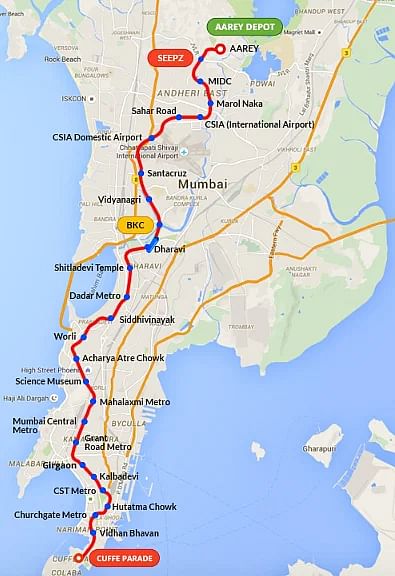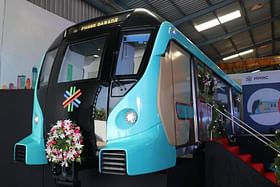The Colaba-Bandra-SEEPZ Metro-3 corridor — the Aqua Line of the Mumbai Metro network will be the city’s first underground metro.
The network will have 26 underground stations, while Aarey is the only “at-grade” station where the depot is being constructed.
Maharashtra Deputy Chief Minister Devendra Fadnavis on 25 March informed the legislative council, that the first phase of Metro-3 between BKC and SEEPZ will be in operation from early 2024, as per a report by Hindustan Times.
Further, 54 per cent of the work of the car shed at Aarey has been completed and the government is trying to complete the work by December.
The development of the car shed at Aarey for the Metro-3, faced lengthy disputes, causing delays, before it was eventually authorised to resume.
While speaking on the final week proposal on the last day of the budget session, Fadnavis provided the current status of all metro projects in Mumbai, including Metro-3.
The Minister stated, “Metro-3 is a very important transport infrastructure, but unfortunately the work was delayed by three years due to a stay given by the Maharashtra Vikas Aghadi (MVA) government on the works of Aarey car shed. As soon as our government took over, we lifted the stay and work restarted after three years of shutdown.”
He added, “About 54 per cent of work was completed in the last six months. The overall work of the Metro-3 project is almost 80 per cent complete. The government has completed 100 per cent rehabilitation of 2,100 project-affected people and construction work for the houses of 650 families in Girgaon-Kalbadevi is in process.”
Metro Line-3 Corridor And Car Shed
Once completed, the Aarey car depot will serve as a crucial facility for the smooth functioning of this Metro line, as it will be used for parking and maintaining all the trains to ensure safe operations.
The facility will include an administrative building, operation control, inspection and maintenance workshops, as well as stabling lines for train parking.
The Colaba-Bandra-SEEPZ Metro-3 corridor — the Aqua Line of the Mumbai Metro network will be the city’s first underground Metro.
The network will have 26 underground stations, while Aarey is the only “at-grade” station where the depot is being constructed.
The line spans approximately 33.5 km, which runs between Colaba (Cuffe Parade) in the extreme south of the city, to the Special Electronics Export Processing Zone (SEEPZ) in the north-central, through Bandra.
It will connect some of the city’s most congested regions, as well as key financial hubs such as Nariman Point, Bandra-Kurla-Complex (BKC), Fort, Worli, Lower Parel and Goregaon.

Further, following a report by the Indian Express, the Mumbai Metro Rail Corporation Ltd (MMRCL) plans to operate the Aqua Line commercially with nine trains, each consisting of eight coaches.
The arrival of these trains is expected by July, which will be a significant milestone towards the launch of the first phase of the corridor.
MMRCL Begins Restoring Roads
With the construction work of the fully underground network drawing to a close, the MMRCL has devised a plan to restore roads at 17 different locations that fall along the route of this corridor.
MMRCL Managing Director Ashwini Bhide said, “After completing underground station boxes and backfilling, road restoration works are in now progress at various locations, including Bandra-Kurla Complex (BKC), Vidyanagari, Dharavi and Hutatma Chowk stations. Similar works are going on at other stations as well. This is being done in a phased manner as it entails restoration of utilities as well.”, reports FreePressJournal.
The restoration plan aims to complete the roadwork at these locations by the end of May.
Upon completion, a total area of 66,625 sq m, with a cumulative length of 6.338 km, will be returned to Mumbai’s road network, resulting in improved vehicular traffic flow starting from the monsoon season of 2023.
The remaining 5.621 km of road length will be restored between post-monsoon and June 2024, making 90,224 sq m of road and pavement space available to the public.


